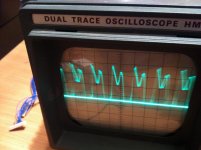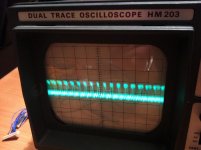QuantumII
Veteran Member
Hi,
I just started to look at the PET, and the first thing that needs repair is the monitor.
It currently displays a single horizontal line, sometimes some areas are brighter than others. Maybe this is the PET outputting video.
I have disassembled the screen, and went over the soldering joints for the yoke and some others. It still gives single horizontal.
I brought out the scope to do some measurements. I got the below images for the horizontal connectors and the vertical connectors on the yoke. (See attached pictures)
It seems there is a pulse on the vertical as well. Weird. I had to fiddle a while with the scope knobs to see anything, but a pulse is there. Could the yoke be wasted? Connections seem fine too. (Not an open connection, like a broken wire would have caused)



I just started to look at the PET, and the first thing that needs repair is the monitor.
It currently displays a single horizontal line, sometimes some areas are brighter than others. Maybe this is the PET outputting video.
I have disassembled the screen, and went over the soldering joints for the yoke and some others. It still gives single horizontal.
I brought out the scope to do some measurements. I got the below images for the horizontal connectors and the vertical connectors on the yoke. (See attached pictures)
It seems there is a pulse on the vertical as well. Weird. I had to fiddle a while with the scope knobs to see anything, but a pulse is there. Could the yoke be wasted? Connections seem fine too. (Not an open connection, like a broken wire would have caused)



